 |
E50416/E56171 stand at Carrog whilst working a Corwen-Llangollen service, 14/7/24. Robert Batty |
| |
|
 |
E50416 rolls down the hill out of Berwyn station towards Llangollen during the annual Railcar Gala, 7/10/23. Chris Moxon |
| |
|
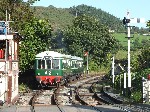 |
E50416/E56171 departs Glyndyfrdwy on a warm summer evening with the 17:05 Carrog-Llangollen service, 14/9/19. Chris Moxon |
| |
|
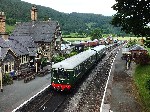 |
E50416/E56171 waits at Carrog with the 16:12 Carrog-Corwen service, 3/6/18. Chris Moxon |
| |
|
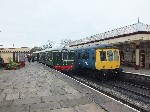 |
E50416 passes W55001 on driver experiences at Ramsbottom, 3/11/17. Chris Moxon |
| |
|
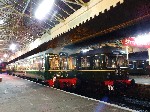 |
E50416 posed with Sc51485 during the photo charter, 3/11/17. Chris Moxon |
| |
|
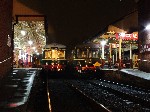 |
E50416 posed with Sc51485 during the photo charter, 3/11/17. Chris Moxon |
| |
|
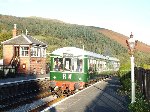 |
E50416/E56171 arrive into Carrog operating one of the final trains of the day during the "Railcar 60" event, 4/10/14. Chris Moxon |
| |
|
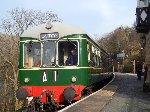 |
E50416 calls at Berwyn, 8/3/14. Peter Dickinson |
| |
|
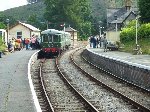 |
E50416 & E56171 in service at Glyndyfrdwy, 28/8/12. Llangollen Railcar Group |
| |
|
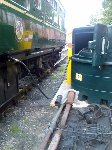 |
50416 being refuelled after having seen the most use recently of the Llangollen Railcar fleet. 1,100 litres of fuel later both were taken away from the fuel point so that the 104 could pass them to work the day's service, 13/6/11. Llangollen Railcar Group |
| |
|
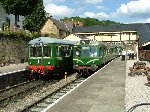 |
50416 alongside Class 127 51618 at Llangollen during the 2010 Railcar Gala, 26/6/10. Chris Moxon |
| |
|
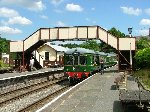 |
50416 & 56171 stand at Glyndyfrdwy during the 2010 Railcar Gala, 26/6/10. Chris Moxon |
| |
|
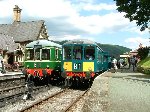 |
50416 alongside Class 104 50454 at Carrog during the 2010 Railcar Gala, 26/6/10. Chris Moxon |
| |
|
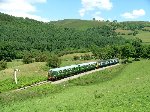 |
50416 & 56171 lead Class 108 51907 & 54490 past Garthydwr during the 2010 Railcar Gala, 26/6/10. Chris Moxon |
| |
|
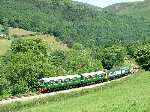 |
50416 & 56171 lead Class 108 51907 & 54490 near Glyndyfrdwy during the 2010 Railcar Gala, 26/6/10. Chris Moxon |
| |
|
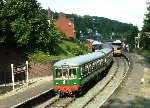 |
50416 & 56171 stand at Llangollen during the 2010 Railcar Gala, 26/6/10. Chris Moxon |
| |
|
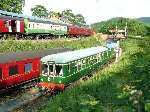 |
50416 & 56171 depart Llangollen during the 2010 Railcar Gala, 26/6/10. Chris Moxon |
| |
|
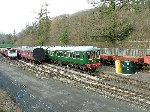 |
50416 stabled at Prntrefelin Carriage Sidings, 10/4/10. Chris Moxon |
| |
|
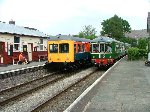 |
Two Wickham's together: 50416 passes visiting railbus 999507 at Glyndyfrdwy during the 2007 Railcar Gala, 9/6/07. Chris Moxon |
| |
|
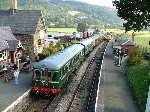 |
50416 at Carrog, 9/6/07. Chris Moxon |
| |
|
 |
50416/56171 & 50454/50528 bask in the sunshine at Glyndyfrdwy, 17/3/07. Simon Edwards |
| |
|
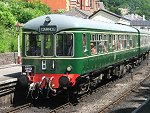 |
50416 at Llangollen Station during the DMU Gala, 11/6/06. Bill Taylor |
| |
|
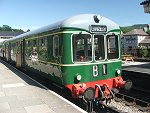 |
50416 at Llangollen Station during the DMU Gala, 11/6/06. Bill Taylor |
| |
|
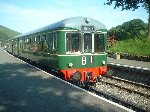 |
50416 at Carrog during the 2006 Railcar Gala, 10/6/06. Chris Moxon |
| |
|
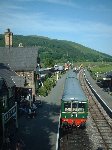 |
50416 at Carrog during the 2006 Railcar Gala, 10/6/06. Chris Moxon |
| |
|
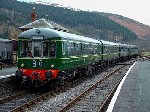 |
E50416/E56171 & M50454/M50528 arrive into Carrog, 26/2/05. Brian Battersby |
| |
|
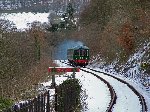 |
E50416/E56171 on the approach to Berwyn, 29/2/04. Brian Battersby |
| |
|
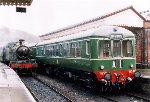 |
50416 at Llangollen during its launch, Feb 2003. Chris Moxon |
| |
|
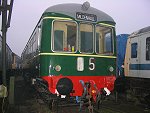 |
50416 soon after emerging from Butterley DMU works, 6/11/03. Ian Francis |
| |
|
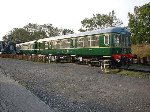 |
The two cars were briefly reunited when they were shunted round so that the power car could be brought next to the roll of lino which had been laid out ready to cover the floors, Sep 2003. Llangollen Railcar Group |
| |
|
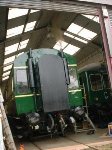 |
The number 2 engine fires up for the first time. Both engines started readily and since then the power car has moved a few feet under its own power for the first time in over 10 years, Sep 2003. Llangollen Railcar Group |
| |
|
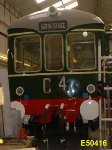 |
50416 awaits final paint touches, Jun 2003. Llangollen Railcar Group |
| |
|
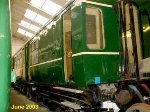 |
50416 awaits final paint touches, this is the brake end of the power car in the area which was once converted to a kitchen , Jun 2003. Llangollen Railcar Group |
| |
|
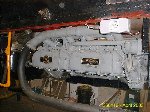 |
The engines have been fitted with an updated fire detection system which, while not original is much more reliable. The light coloured box replaces the old red flame switch and an electrical wire replaces the old brass fire detection cord, Apr 2003. Llangollen Railcar Group |
| |
|
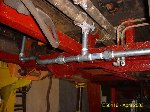 |
Underneath the guard's van some new conduit has been run which will link the vacuum brake system to the passenger communication cords which had been removed when the vehicle was cleared of asbestos some years ago, Apr 2003. Llangollen Railcar Group |
| |
|
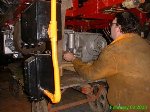 |
In February 2003, there was an "intense" day on 50416 fitting the majority of the overhauled machanical componets in one go. The first components to be refitted were the fuel tanks which were quickly followed by the no 2 gearbox. This box is almost the size of the engine of a small car and is fitted to an inaccessable place high up in the frames. Here Andy Mould manhandles the box into place from its temporary transporting trolley, 2/2/03. Llangollen Railcar Group |
| |
|
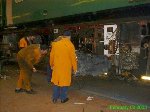 |
In February 2003, there was an "intense" day on 50416 fitting the majority of the overhauled machanical componets in one go. The second gearbox and the air tanks were fitted by lunchtime after which it was the turn of the first of the engines. Watched by retired Traction Inspector Bill Braley and current Inspector Dewi Davies the team edge the huge power unit underneath the Wickham power car. This unit is almost six feet long and four feet wide and is of a design which dates from pre World War 2, 2/2/03. Llangollen Railcar Group |
| |
|
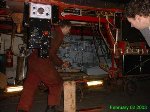 |
In February 2003, there was an "intense" day on 50416 fitting the majority of the overhauled machanical componets in one go. Once underneath the carriage the engine had to be rotated through 90 degrees so that it could be fitted. Chris Hatton is seen here pushing the engine into its final place watched by Stuart "Railcar" Mackay. Given the first generation railcar's habit of throwing oil around everywhere it is doubtful that the engine will look as clean as this for long! 2/2/03. Llangollen Railcar Group |
| |
|
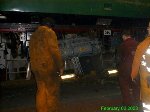 |
In February 2003, there was an "intense" day on 50416 fitting the majority of the overhauled machanical componets in one go. With the no 2 engine bolted firmly into place attention turned to doing the whole job all over again with the no 1 engine. This one is fitted the opposite way round and on the other side of the coach. Here the fork lift has been removed and the engine is seen hanging on the built-in winching arrangement, 2/2/03. Llangollen Railcar Group |
| |
|
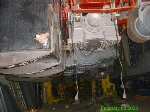 |
In February 2003, there was an "intense" day on 50416 fitting the majority of the overhauled machanical componets in one go. A view of the underside showing from left to right, fuel tank, engine, gearbox and heater. During the following week teams of volunteers built up pipework forming water and exhaust systems while others assisted with wiring components.The car has now been refuelled and merely awaits some fuel lines, wiring and the new batteries before a start up is attempted, 2/2/03. Llangollen Railcar Group |
| |
|
 |
The first of the rebuilt engines has arrived at the Midland Railway Centre ready for fitting and is seen here being delivered. It is a Leyland 680 model which is common to many other Railcars. This one was last overhauled in the 1970s and was full of emulsified oil when it was dismantled, Jan 2003. Llangollen Railcar Group |
| |
|
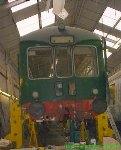 |
50416 now back on its jacks ready for the fitting of the engines, gearboxes and other large units, Dec 2002. Llangollen Railcar Group |
| |
|
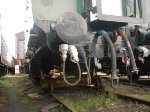 |
The rear power car bogie has been removed for attention, Aug 2002. Llangollen Railcar Group |
| |
|
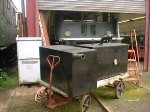 |
The fuel tanks have been completed and now await fitting, Aug 2002. Llangollen Railcar Group |
| |
|
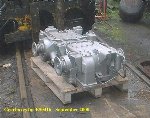 |
Refurbished components for the power car are beginning to come back. The two gearboxes were delivered by road as were the two exhausters and numerous cab instruments and fittings, Sep 2000. Llangollen Railcar Group |
| |
|
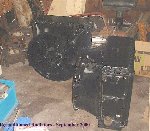 |
The radiators from the power car had been taken away and stripped down by volunteers. Then they had been taken away for pressure testing, recoring and repairs and then were re-assembled and painted, Sep 2000. Llangollen Railcar Group |
| |
|
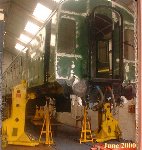 |
50416 jacked up so that the bogies and running gear can be removed. At the same time some remedial work has been done on the body of the car, Jun 2000. Llangollen Railcar Group |
| |
|
 |
One bogie has been completely stripped down and the wheels taken out so that the final drive and the wheelsets and axles can be inspected, Jun 2000. Llangollen Railcar Group |
| |
|
 |
The bogie frame has been shotblasted and then painted. New springs have been ordered and fitted and the brake gear and rigging has been re-bushed as required, Jun 2000. Llangollen Railcar Group |
| |
|
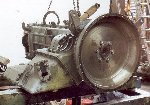 |
The first of the two engines has been stripped down into the smallest pieces. It has been found to be in poor condition, with congealed oil in the sump and water damage to the bores, Jun 2000. Llangollen Railcar Group |
| |
|
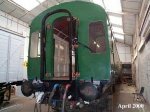 |
At the rear of the vehicle the corridor connection steelwork was returned to its rightful place after an absence of some four years. The steelwork had been refurbished but it still needed its canvas covering. Also missing were the vertical exhaust stacks. However inspection revealed that the whole exhaust system required replacing as the 20 years of storage had rendered it useless, Apr 2000. Llangollen Railcar Group |
| |
|
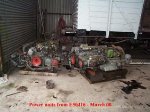 |
All the mechanical units, eg the engines, gearboxes, exhausters were removed and were despatched to specialist contractors for refurbishing. The engines appeared to have last been looked at some 30 years ago and were in poor condition, Mar 2000. Llangollen Railcar Group |
| |
|
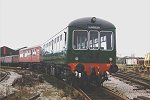 |
50416 at Swanwick, 1999. John Joyce |
| |
|
 |
Work completed and a coat of primer applied. All that needs fitting are the corridor connection and the engine exhaust pipes. The interior is still, however an empty shell. Llangollen Railcar Group |
| |
|
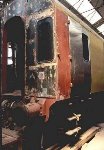 |
The rear of the coach was rebuilt and two brand new doors were made. Two windows in the rear which had been plated over were reinstated. The rear small window was removed and a new bodyside made to cover the area where it had been. Lastly the gutters were removed and replaced with authentic types mounted in the correct place. Llangollen Railcar Group |
| |
|
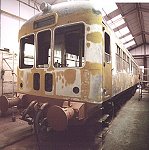 |
50416 in Butterley carriage shed, 31/8/97. Stuart Mackay |
| |
|
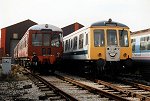 |
50416 at Swanwick, Midland Railway Centre in the company of Class 114 56006. Ian Francis |
| |
|
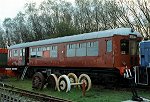 |
50416 at the Chasewater Railway. Ian Francis |
| |
|
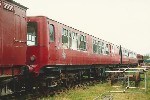 |
50416 stored at the Chasewater Railway. Tim Major |
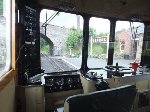 |
A view of the driving position inside E50416 at Carrog, 15/8/14. Richard Alger |
| |
|
 |
A view of the front saloon inside 50416, ten years after restoration, looking forwards towards the cab, 6/13. Michael Cawood |
| |
|
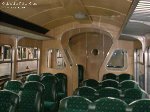 |
The interior of the 50416 has been rebuilt to the same high standard and is virtually indistinguishable from the original which was installed in 1957 and ripped out in 1970. Note the attention to detail - including the leatherette edgings to the seats and the "porthole" to the Guard's van, Feb 2004. Llangollen Railcar Group |
| |
|
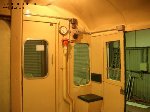 |
It is hard to believe that this area was once a kitchen and that it is the same vehicle. As with the rest of the Wickham much attention has been paid to historical accuracy with data being taken from original photographs and drawings, Feb 2004. Llangollen Railcar Group |
| |
|
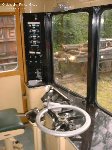 |
Both cabs have been rebuilt to a very high standard and feature original features such as leatherette seat covering and varnished wooden door frames, Feb 2004. Llangollen Railcar Group |
| |
|
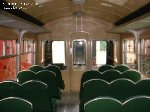 |
Looking towards the driving cab of the power car it is hard to imagine that this is the same vehicle which was the empty shell featured in some of the earlier updates. It is a great testimony to those who have worked on the Project. The Llangollen Railcar Group would like to thank them all as well as the Heritage Lottery Fund, without whose help the Project would not have been possible, Feb 2004. Llangollen Railcar Group |
| |
|
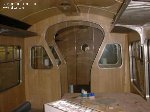 |
This is the rear part of the power car showing the "porthole" door into the guard's compartment, Sep 2003. Llangollen Railcar Group |
| |
|
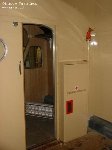 |
In the guard's van the emergency cupboard and interior have been finished in authentic 1950's style. Woe betide anyone loading dirty items in this van! Sep 2003. Llangollen Railcar Group |
| |
|
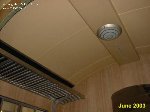 |
he new lighting galleries and luggage racks in place. This is the first area to be completed and is the small compartment outside of the guard's van. Note how accurate the lighting galleries are to the original pattern, Jun 2003. Llangollen Railcar Group |
| |
|
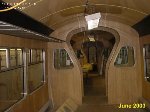 |
The interior of the power car has had its internal windows added since the last update. Also added have been the rubber strips with aluminium surrounds which go behind the luggage racks. On the left can be seen a partly assembled luggage rack. The racks have to be assembled to the back rail, which then has to be fitted to the wall before the front rail can be added. This is a very time-consuming operation but the finished racks are very strong and attractive. On the floor is a completed section of lighting ducting. Each section has been made to the correct length offsite and has been delivered pre-coloured and with holes already cut for the lighting. Once the lino is laid then the new heating ducts will be fitted over the inners which can be seen at floor level, Jun 2003. Llangollen Railcar Group |
| |
|
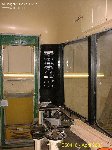 |
The power car cab is now fitted with all its controls and instruments and is ready for final fitting out, Apr 2003. Llangollen Railcar Group |
| |
|
 |
50416 is now fully panelled inside and now awaits seats, lighting gantries and luggage racks. Note that the new roof is not painted all the way down. This is because the Wickham cars have a rubber backing piece behind the luggage racks, Apr 2003. Llangollen Railcar Group |
| |
|
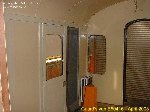 |
Inside the brake van the new walls can be seen to advantage. At the start of the project there was a half-height window to the left of the door and the window at the rear was plated over. One of the doors was also plated over and the other had been altered to open the wrong way, Apr 2003. Llangollen Railcar Group |
| |
|
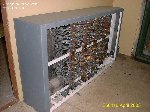 |
This junction box will be hidden behind the driver's seat of the power car. All the wiring is new and the box is one of four in the car - one of which was missing completely and had to be built from scratch. The photo gives an idea of the scale of the work, Apr 2003. Llangollen Railcar Group |
| |
|
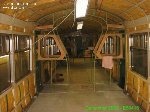 |
Inside the power car the whole body has been insulated with glass fibre and the new seat tracks have been fitted. This view was taken just before work started to fix to bonded aluminium panels to the interior, Dec 2002. Llangollen Railcar Group |
| |
|
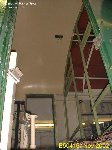 |
The cab roof dome has now been put into the power car and work is progressing on assembling the cab fittings. Here the wiring is being put into the roof, Nov 2002. Llangollen Railcar Group |
| |
|
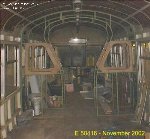 |
nside the power car the partitions are assembled and in place. The lavatory pan is not in its correct place!
Work will now start to put in the body insulation before the roof and the body panels are added, Nov 2002. Llangollen Railcar Group |
| |
|
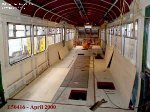 |
Within a short time the inside of the power car was painted. The cab area was stripped and priming and painting carried out. The original insulation was then replaced by new materials and work carried on to replace the floor inside. This made the interior easier to work on, Apr 2000. Llangollen Railcar Group |
| |
|
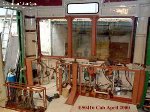 |
This striking photograph shows the cab area of the power car which had been stripped down and painted. Individual components were being shipped to various places as volunteers tackled them as "homework" projects. Amongst these are brake parts, controls and electrical installations. It was to be almost two years before they were all reunited again . Llangollen Railcar Group |
| |
|
 |
The first job tackled was to strip the old floor from the power car and wire brush and sand it so it could be painted. The inner skin and roof was also sanded and painted. Everything was found to be in good order, although there was some corrosion between aluminium and steem parts. The only corrosion found was in small areas of the floor, Apr 2000. Llangollen Railcar Group |
| |
|
 |
Inside the guard's compartment after the asbestos ( and all the interior of the coach ) had been removed.
The forward of the two windows had been reduced to half size and an extra one inserted behind it whilst the unitwas in engineers' service. Llangollen Railcar Group |














































































